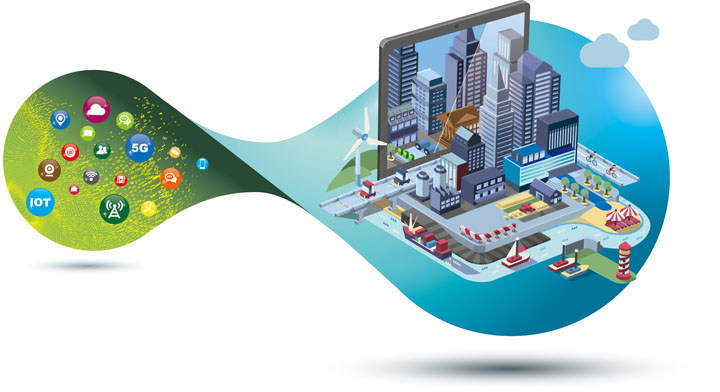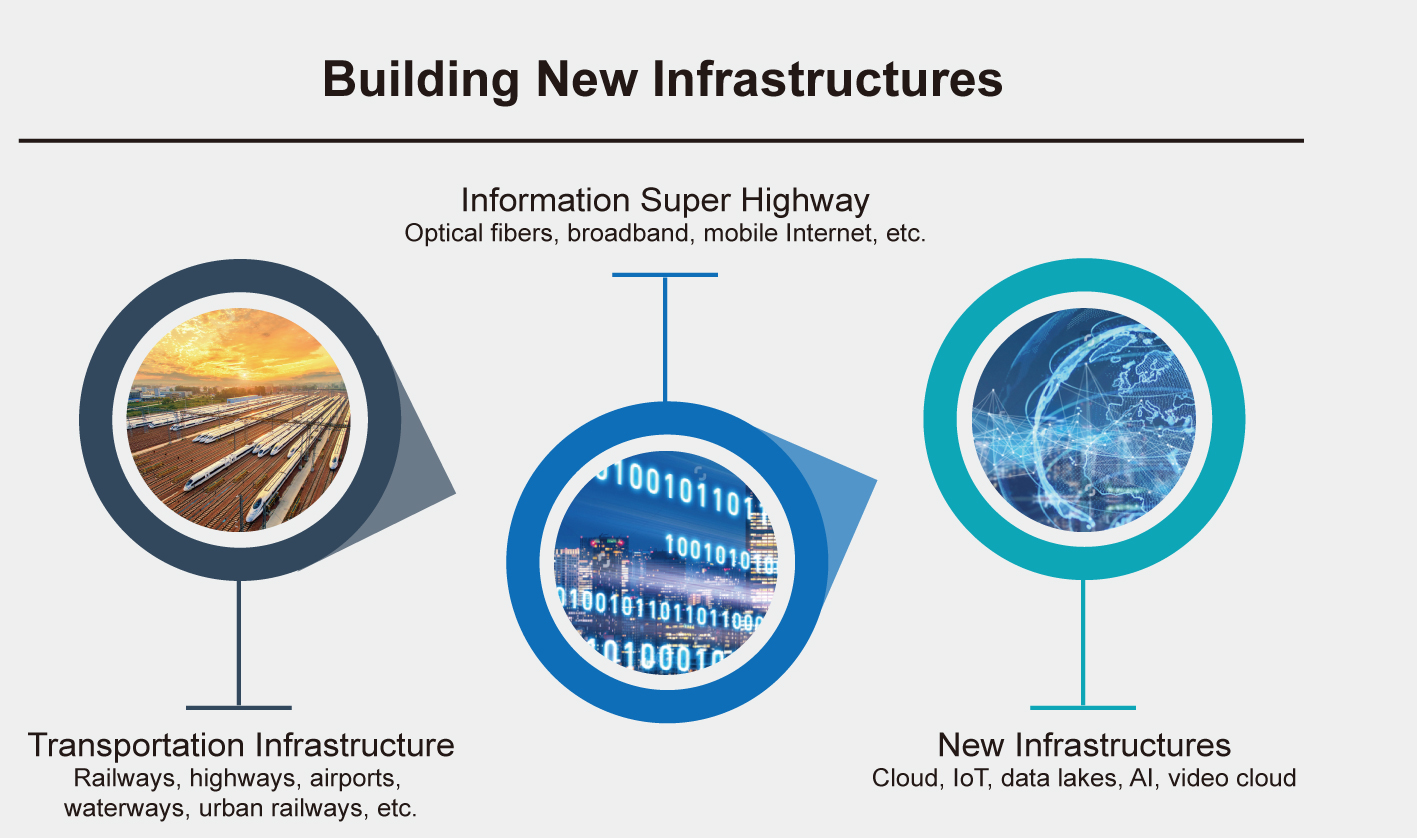Intelligent Cities Enable the Digital Economy and Drive Growth
This site uses cookies. By continuing to browse the site you are agreeing to our use of cookies. Read our privacy policy>
![]()
Enterprise products, solutions & services

In the 21st century, the world has unprecedented development opportunities. For cities worldwide to capitalize on those opportunities, it is imperative to use new technologies to drive the development of the new economy.
The 2016 G20 summit — held in Hangzhou, China — proposed four initiatives for promoting innovative economic growth: innovation, a new industrial revolution, structural reform, and the digital economy.
Over the past few years, major economies around the world have reached consensus on the importance of digitization — the conversion of information and data into a computer readable format — and Information and Communications Technology (ICT). They agree that digitization has vast potential for promoting economic growth and prosperity, and ICT is indispensable in growing the digital economy.
• ICT Investment Is Key to Digital Economic Development
In 2018, Oxford Economics and Huawei collaborated on a digital economy research project that analyzed the economic data of 79 countries and regions over the past 15 years and provided forecasts. The researchers learned that the growth rate of the digital economy in the past 15 years was 2.5 times the global GDP growth rate. Over a 10-year-period that started in 2015, the digital economy will be the main engine of global economic growth. In 2025, the digital economy will account for 24 percent of the global economy — a 9 percent increase from 2015.
The researchers also discovered that the long-term Return On Investment (ROI) in digital technologies is 6.7 times that in non-digital technologies. A one dollar investment in ICT today would produce an average return of 20 dollars in 2025, while the average ROI for non-ICT investment of one dollar would only be worth three dollars by 2025. ICT investment plays a crucial role in driving economic development and has become a key engine behind economic growth.
• Accelerating Transformation of the Digital Economy to Industry Digitization
The development of the digital economy is characterized by the accelerating transformation from the consumer Internet to industry digitization.
The consumer Internet era has been characterized by the ‘attention economy,’ which has used the demographic dividend of a rapidly-growing number of Internet users to deliver optimal experiences to consumers. The demographic dividend is now waning; the driving force of the consumer Internet is weakening, and the development of the digital economy is entering an industry digitization phase.
As the industry digitization era takes hold, the number of Internet of Things (IoT) connections will reach 100 billion by the end of 2025. With intelligent analysis and decision-making, the massive amounts of data generated by the hundreds of billions of connections will boost the productivity of traditional industries and bring many more benefits to society than the consumer Internet did. The scale of the digital economy will increase from US$300 billion in the consumer Internet era to US$23 trillion in the industry digitization era.

• The Intelligent City Is the Foundation of the Digital Economy
With the prosperity of commerce and trade, the accumulation of knowledge, and the advancement of science and technology, cities are the focal points for economies. Since we entered the industrial era, industrial revolutions have driven the advance of science and technology as well as the development of cities, creating a huge amount of talent and funds that fuel technological revolutions and industry upgrades.
There is now consensus among countries worldwide about the digital economy. More cities are looking for ways to transform and upgrade regional industries from the perspective of the digital economy. Huawei believes that Intelligent City construction should focus on improving governance, benefiting the people and promoting industry prosperity, so that Intelligent Cities can become the foundation of growing the digital economy. The digital economy will also become a main characteristic of industry development in Intelligent Cities.
• Five New Infrastructures for the Digital Economy
The infrastructures that are vital to development greatly vary from era to era. In the industrial era, we prioritized infrastructure components such as railways, expressways, and airports. In the consumer Internet era, the infrastructure that matters most is quite different. Take China, for example: In the past 30 years, it has undergone a rapid informatization process. It has built the world’s largest optical fiber and wireless networks, with 37.47 million kilometers of optical cables deployed and 32,000 administrative villages connected to optic networks (with a coverage rate of more than 95 percent). A total of 6.19 million wireless base stations have been constructed and 1.88 million telecommunications towers have been erected in China (there are 2.3 million towers in the world).
The mass construction of this information infrastructure has enabled China to make outstanding achievements in the consumer Internet era, especially in the eCommerce industry. Online retail sales in China are twice those of the US, and the number of people who call a taxi or order a meal online exceeds 200 million per day. Chinese people are getting used to a cashless society in which they make many of their purchases with their smartphones.
In the future, as the focus of the digital economy shifts toward the Industrial Internet, and Intelligent Cities become the foundation of the digital economy, Huawei believes that the five new infrastructures of Intelligent Cities should be the cloud, IoT, data lakes, Artificial Intelligence (AI), and video cloud.
IT systems have typically been constructed in a siloed or isolated mode. In the future, IT construction will be based on the cloud. The deployment and development of IoT, data lakes, AI, and video cloud will be based on the cloud, which will be the foundation of all infrastructures.
In future Intelligent City construction, the deployment of these infrastructures will be an indicator of whether or not a city is smart.

• The Digital Economy Must Drive the Development of the Real Economy
The digital economy consists of two parts. One is digital industrialization — this is the information industry. The information industry includes emerging sectors, such as electronic information manufacturing, telecommunications, and software services. The other is industry digitization, which refers to using digital technologies to increase output and efficiency. Industry digitization is an integrated part of the digital economy, including the increase in production quantity and productivity because of the application of digital technologies in traditional industries. The new output is an important part of the digital economy.
In the work report of the Two Sessions (NPC & CPPCC) in 2018, the Chinese government proposed to “develop new energy and momentum” and “fuel the construction of a digital China.” China’s positioning of the digital economy is not limited to emerging industries; the digital economy is considered a national strategy to drive the upgrade of traditional industries.
Most enterprises still focus on mining the value of management data through systems such as Customer Relationship Management (CRM) and Enterprise Resource Planning (ERP). However, this data accounts for only 10 percent of the total amount of an enterprise’s data, and its value is very limited. Ninety percent of data comes from enterprises’ production systems. Real digitization requires the transformation of enterprise production systems (Operation Technology, OT), the digitization of the physical world, and the integration of production data with management data. This is the only way that data can generate greater business value.
Enterprises have so far been unable to effectively perceive, collect, and analyze the 90 percent of data from the physical world. The real, fundamental challenge in developing the digital economy is working out how to digitize the physical world.
• Industry Digital Transformation Relies on ‘Talent Dividends’
Huawei founder Ren Zhengfei recently said that “a country’s prosperity starts in a primary school,” and he advocated “using the best talent to develop more outstanding talent.” Ren’s comments, which highlighted the importance of basic education to China’s development, were widely praised online.
There is a sense that, in the digital economy era, China has not made enough progress in terms of digital technology education and talent cultivation. For example, according to the Global AI Talent Report published by LinkedIn, the scale of the AI workforce in the US exceeds 850,000; the number in India is 150,000; and there are 140,000 in the UK. In China, there are only about 50,000 AI employees.
To bridge that gap and boost China’s digital economic development, governments, enterprises, research institutes, and colleges should collaborate to bring to bear their respective strengths, develop scientific talent development policies, effectively implement policies, and create ‘talent dividends.’
Huawei has helped construct more than 200 Intelligent Cities in more than 40 countries around the world. Building on this experience, the company applies Maslow’s “hierarchy of needs” to its Intelligent City construction model, to ensure effective development. We divide the digital transformation needs of a city into four levels:
• At the base is the need for infrastructure, which is the basis for building a digital economy. There are five core infrastructures for Intelligent City deployment: the cloud, IoT, data lakes, video cloud, and AI. IoT includes both typical IoT technologies as well as nascent technologies such as 5G and Wi-Fi 6.
• The second layer is security assurance. Ensuring the security of the physical and digital worlds is the lifeline of urban development.
• Next, is implementing industry digitization to better grow the real economy.
• Finally, there is the intelligent brain, which acts like the human brain in the sense that it guides the operations of Intelligent Cities.
This hierarchy helps execute the Intelligent City development strategy.

To build great buildings, you need a solid and substantial foundation. And urban digital infrastructure is somewhat similar. We need to support the all-round, all-angle, and full-chain reconstruction of traditional urban industries and improve the productivity of all factors. Based on the extensive experience we have accumulated in digital transformation and cooperation with industry-leading enterprises, Huawei has developed Huawei Horizon Digital Platform as its foundation for digital infrastructure.
Huawei Horizon Digital Platform can coordinate various new ICT technologies and streamline different types of data. It supports rapid development and flexible deployment of upper-layer applications, and it streamlines bottom-layer connections, achieving synergy between the cloud, the pipe (or the network), and devices. In this way, cities can use the platform to lower the threshold for using new technologies and quickly integrate systems. Huawei Horizon Digital Platform has played an important role in the construction of Intelligent Cities around the world, paving the way for their digital transformation and smart construction.
• A Perfect Combination: Huawei Technologies and Yiyang’s Approach
In Yiyang, Hunan Province, China, Huawei closely collaborated with the municipal government to outline the step-by-step Intelligent City development approach, with data as the source, industry as the core, public welfare as the goal, and the city as the foundation. The project was a perfect combination of Huawei technologies and Yiyang’s approach. Yiyang has constructed infrastructure such as an eGovernment cloud data center, IoT, video cloud, GIS, and big data. Based on the open capabilities of these platforms and Yiyang’s service requirements, Huawei collaborated with ecosystem partners to develop more than 10 services and applications for Yiyang, including smart agriculture, smart government, the Xueliang project (a public security project), Intelligent City management, smart water conservation, smart education, and smart healthcare. These applications and services improve the city’s management and services, enhance its residents’ sense of wellbeing, and boost industry development. In particular, the ‘HUAWEI CLOUD + AI + IoT’ solution benefited 200,000 farmers in 81 towns and 1,391 villages in Yiyang. The per capita disposable income in rural areas of Yiyang is more than 11 percent higher than Hunan province’s average.
• Lanzhou New District: Using Intelligence to Upgrade Industries
In Lanzhou City, Gansu Province, China, Huawei and its partners have enabled the construction of a new smart district in the city by using Huawei Horizon Digital Platform. A new district was built using new concepts and methods. Intelligent technologies were used to upgrade all industries, and the largest data industry park in Northwestern China was set up. Smart healthcare was implemented, providing an improved experience for patients. Through the unified management and data sharing of the city’s IoT, the level of network resource concentration was improved eight-fold, allowing Lanzhou to offer Internet + government services.
• Longgang: ‘Smart Brain’ Is Responsible for the City’s Holographic Management System
In Longgang District, Shenzhen, China, Huawei helped build an ‘Intelligent Brain,’ which is an Intelligent Operations Center (IOC) that connects more than 30 service systems of government agencies, offices, and bureaus. The IOC presents city resources and information, such as weather, transportation, people flow, public safety, landscape, and drainage, as well as emergency response vehicle information, to city managers. Management departments can use the IoT sensors to obtain real-time traffic information, emergency situation reports, and warnings on crowd density. The ‘Smart Brain’ has become a panoramic Intelligent City management system. It abstracts core value from various service data and intelligently presents it, helping city managers quickly understand the data and make decisions accordingly.
• Gaoqing: Ensuring Safe and Controllable Systems for Hazardous Chemicals
In the Smart Gaoqing project, carried out in Gaoqing County in Shandong Province, China, Huawei and the China Academy of Safety Science and Technology built a cloud-based full-process monitoring platform for the transportation and loading and unloading of hazardous chemicals, streamlining the service systems of the Administration of Work Safety, Quality and Technology Supervision Bureau, Traffic Management Bureau and the Public Security Bureau. Huawei Horizon Digital Platform horizontally integrates new ICT capabilities such as big data, video cloud, GIS map, and cloud computing, making the whole process of loading, unloading, and transporting hazardous chemicals transparent, safe and controllable in real time.
• Yanbu, Saudi Arabia: Using Invisible Intelligence to Safeguard the City
Yanbu is the biggest port city in Al Madinah Province, western Saudi Arabia. The annual flower show is its largest public activity. In 2018, invisible security guards — a group of smart lamp poles — were deployed in the city. In addition to lamps, the poles are also equipped with cameras, Wi-Fi, and LED screens, realizing the deployment of multiple services and systems, such as street lamps, monitoring devices, advertisement functions, and alarm systems, on a single pole, reducing the number of street poles by 80 percent. The HD 4K cameras installed on the smart lamp poles can run around the clock in all scenarios. The cameras continuously transmit data to the security command center in real time. Crowd density can be monitored in real time through crowd analysis, which helps predict traffic congestion in advance and implement proactive traffic distribution. This solution improves experiences for tourists and guarantees security in crowded areas.
Huawei manages the complexities, providing simplicity for our customers: We will help city administrators around the world by providing enabling technologies to drive local industry upgrades and economic growth.